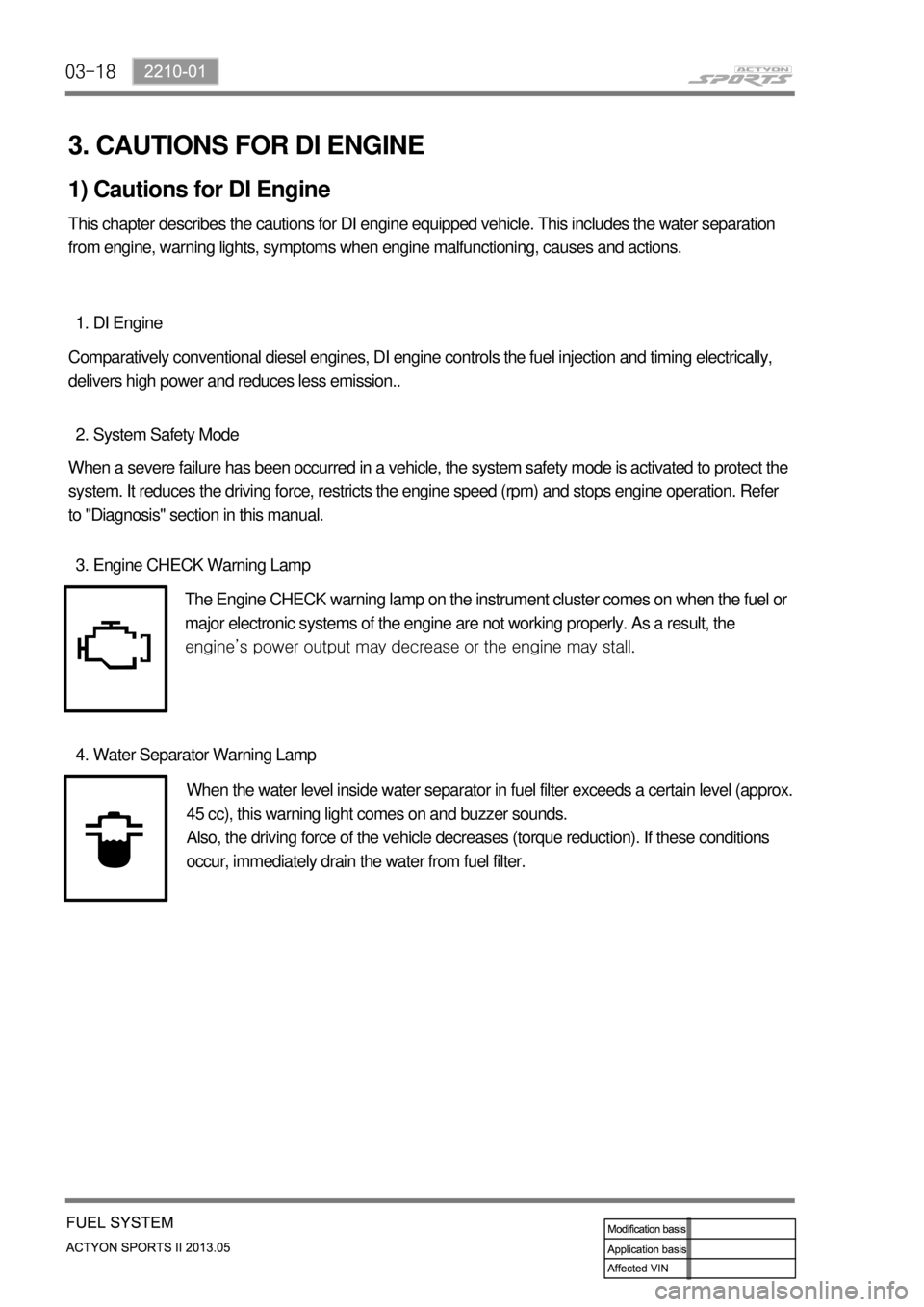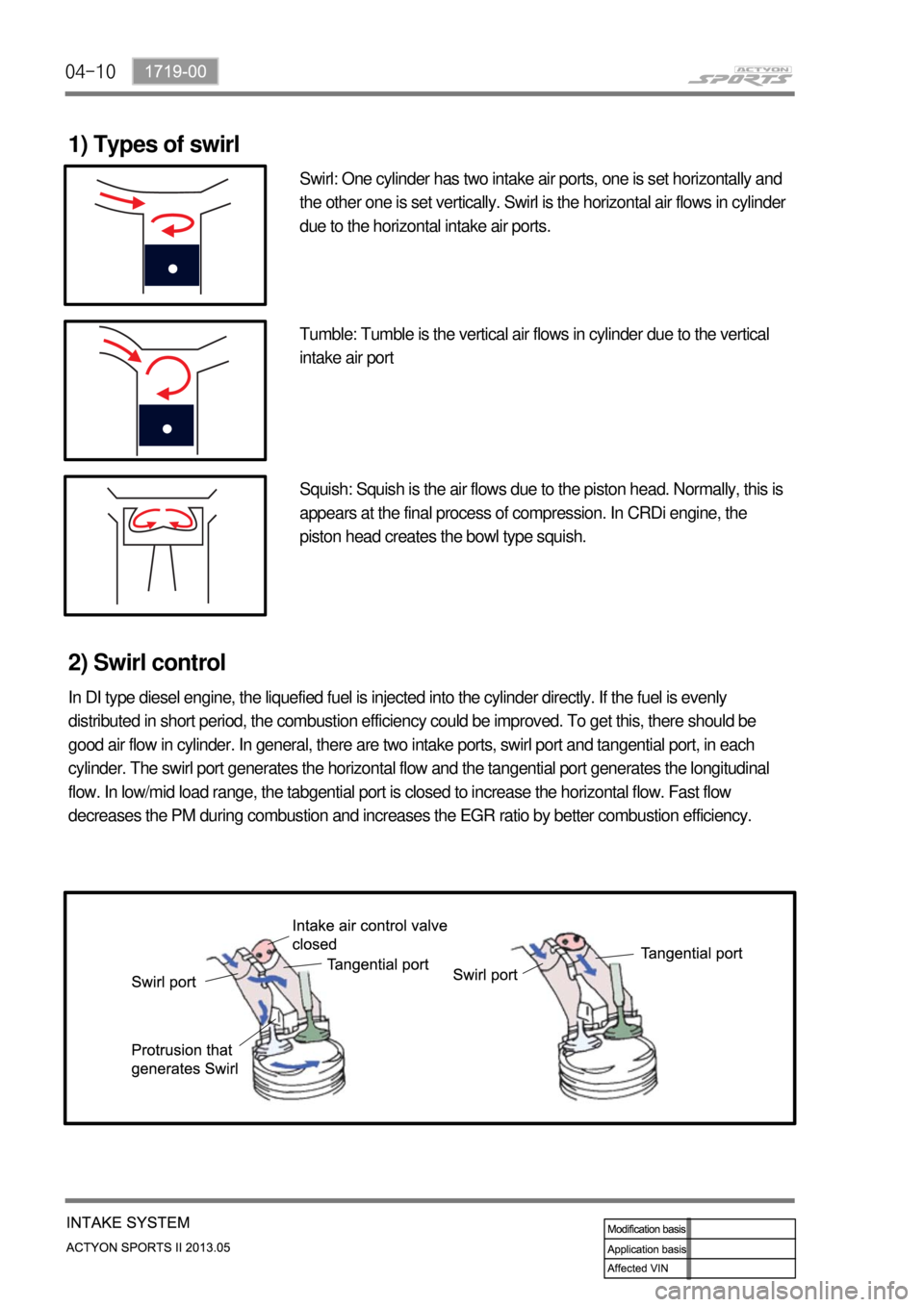Page 4 of 751
01-6
2) Vehicle Identification
Engine Number
(Gasoline Engine)
The engine number is stamped
on the upper rear left-hand side
of the cylinder block.
Engine Number
(Diesel Engine)
The engine number is stamped
on the lower area of cylinder
block behind the Intake
manifold.Vin Label
Chassis Number
The chassis number is
stamped on the frame behind
the front right tire.
Certification Label
The certification label is located
on the driver’s door sill.
Page 9 of 751
01-110000-00
3) Scheduled Maintenance Services (EU) - Diesel Engine
Page 12 of 751
01-14
4) Scheduled Maintenance Services (General) - Diesel Engine
Page 24 of 751

01-70000-00
1) Service Interval
2) Specification and Capacity
Engine oilSpecification Quality class: Ssangyong genuine engine oil (Total Quartz INEO ECS
5W 30, SK ZIC SY 5W 30) or oil Approved by MB Sheet 229.51
Capacity approx. 6.0 litter
Engine
coolantSpecification Ssangyong genuine coolant Anti-Freeze SYC-1025
Capacity approx. 8.5 litter
Severe condition
Frequent stop-and-go traffic, extended idling, short driving distance below 6 km, driving distance below
16 km when the outside temperature remains below freezing
Driving in a hilly or mountainous terrain, sandy, or dusty area
High load driving such as trailer towing
Taxi, patrol service or delivery service (extended idling and excessive driving with low speed) -
-
-
-
DescriptionDaily
inspectionWeekly
inspectionService interval
Engine oil & oil
filterInspection - EU Change every 20,000 km or 12 months
(The service interval should be shortened
under severe conditions)
General Change every 15,000 km or 12 months
(The service interval should be shortened
under severe conditions)
Coolant Inspection - Change every 200,000 km or 5 years
Air cleaner
element- Inspection Diesel EU Change every 20,000 km (The
service interval should be
shortened under severe
conditions)
General Clean every 7,500 km, change
every 15,000 km (The service
interval should be shortened
under severe conditions)
Gasoline Clean every 15,000 km, replace every
60,000 km (The service interval should be
shortened under severe conditions)
Fuel filter - - EU Change every 40,000 km (Draining water
from fuel filter: whenever replacing the
engine oil)
General Change every 45,000 km (Draining water
from fuel filter: whenever replacing the
engine oil)
Page 80 of 751
03-32210-01
1. SPECIFICATION
Description Specification
Fuel Diesel
Fuel filterType Fuel heater + priming pump + water
separator integrated type
Filter type Changeable filter element type
Water accumulating capacity 200 cc
Heater capacity 250W 13.5V
Injector System pressure 1800 bar
High pressure fuel
pumpType Eccentric cam/Plunger type
Operating type Gear driven type
Normal operating temperature-40 ~ 125˚C
Operating pressure 1800 bar
Operating temperature-30 ~ 120˚C
Low pressure fuel
pumpType Vane type
Gear ratio (pump/engine) 0.5 : 1
Pressure 6 bar
Fuel tankCapacity 75 L
Material Steel
Fuel sender Single sender type
Change interval EU every 40,000 km
GEN every 45,000 km
Water separation
intervalEU every 20,000 km
GEN every 15,000 km
Page 95 of 751

03-18
3. CAUTIONS FOR DI ENGINE
1) Cautions for DI Engine
This chapter describes the cautions for DI engine equipped vehicle. This includes the water separation
from engine, warning lights, symptoms when engine malfunctioning, causes and actions.
DI Engine 1.
Comparatively conventional diesel engines, DI engine controls the fuel injection and timing electrically,
delivers high power and reduces less emission..
System Safety Mode 2.
When a severe failure has been occurred in a vehicle, the system safety mode is activated to protect the
system. It reduces the driving force, restricts the engine speed (rpm) and stops engine operation. Refer
to "Diagnosis" section in this manual.
Engine CHECK Warning Lamp 3.
The Engine CHECK warning lamp on the instrument cluster comes on when the fuel or
major electronic systems of the engine are not working properly. As a result, the
<008c0095008e00900095008c02c5009a004700970096009e008c009900470096009c009b0097009c009b00470094008800a00047008b008c008a0099008c0088009a008c0047009600990047009b008f008c0047008c0095008e00900095008c0047009400
8800a00047009a009b0088009300930055>
Water Separator Warning Lamp 4.
When the water level inside water separator in fuel filter exceeds a certain level (approx.
45 cc), this warning light comes on and buzzer sounds.
Also, the driving force of the vehicle decreases (torque reduction). If these conditions
occur, immediately drain the water from fuel filter.
Page 97 of 751

03-20
(2) Di engine and its expected problems and remedies can be caused by
water in fuel
System supplement against paraffin separation ▶
In case of Diesel fuel, paraffin, one of the elements, can be separated from fuel during winter and then
can stick on the fuel filter blocking fuel flow and causing difficult starting finally. Oil companies supply
summer fuel and winter fuel by differentiating mixing ratio of kerosene and other elements by region and
season. However, above phenomenon can be happened if stations have poor facilities or sell improper
fuel for the season. In case of DI engine, purity of fuel is very important factor to keep internal
preciseness of HP pump and injector.
Accordingly, more dense mesh than conventional fuel filter is used. To prevent fuel filter internal clogging
due to paraffin separation, SYMC is using fuel line that high pressure and temperature fuel injected by
injector returns through fuel filter to have an effect of built-in heater (see fuel system).
System supplement and remedy against water in fuel ▶
As mentioned above, some gas stations supply fuel with excessive than specified water. In the
conventional IDI engine, excessive water in the fuel only causes dropping engine power or engine
hunting. However, fuel system in the DI engine consists of precise components so water in the fuel can
cause malfunctions of HP pump due to poor lubrication of pump caused by poor coating film during high
speed pumping and bacterization (under long period parking). To prevent problems can be caused by
excessive water in fuel, water separator is installed inside of fuel filter. When fuel is passing filter, water
that has relatively bigger specific gravity is accumulated on the bottom of the filter.
Water drain from water separator ▶
If water in the separator on the fuel filter exceeds a certain level, it will be supplied to HP pump with fuel,
so the engine ECU turns on warning lamp on the meter cluster and buzzer if water level is higher than a
certain level.
Due to engine layout, a customer cannot easily drain water from fuel filter directly, so if a customer
checks in to change engine oil, be sure to perform water drain from fuel filter.
Water
separator
To separate the water from the fuel filter,
remove the fuel filter assembly first.
Page 111 of 751

04-10
1) Types of swirl
Swirl: One cylinder has two intake air ports, one is set horizontally and
the other one is set vertically. Swirl is the horizontal air flows in cylinder
due to the horizontal intake air ports.
Tumble: Tumble is the vertical air flows in cylinder due to the vertical
intake air port
Squish: Squish is the air flows due to the piston head. Normally, this is
appears at the final process of compression. In CRDi engine, the
piston head creates the bowl type squish.
2) Swirl control
In DI type diesel engine, the liquefied fuel is injected into the cylinder directly. If the fuel is evenly
distributed in short period, the combustion efficiency could be improved. To get this, there should be
good air flow in cylinder. In general, there are two intake ports, swirl port and tangential port, in each
cylinder. The swirl port generates the horizontal flow and the tangential port generates the longitudinal
flow. In low/mid load range, the tabgential port is closed to increase the horizontal flow. Fast flow
decreases the PM during combustion and increases the EGR ratio by better combustion efficiency.